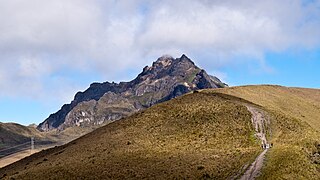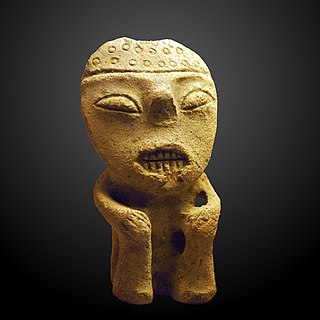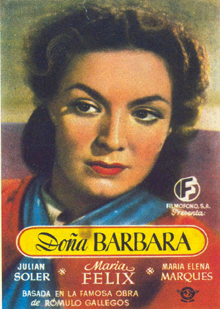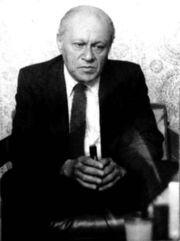Related Research Articles

Ecuador, officially the Republic of Ecuador, is a country in northwestern South America, bordered by Colombia on the north, Peru on the east and south, and the Pacific Ocean on the west. Ecuador also includes the Galápagos Islands in the Pacific, about 1,000 kilometers (621 mi) west of the mainland. The capital is Quito.

Ecuadorians are the people of Ecuador.

Pichincha is a stratovolcano in Ecuador. The capital Quito wraps around its eastern slopes.
The majority of Ecuador's population is descended from a mixture of both European and Amerindian ancestry. The other 10% of Ecuador's population originate east of the Atlantic Ocean, predominantly from Spain, Italy, Lebanon, France and Germany. Around the Esmeraldas and Chota regions, the African influence would be strong among the small population of Afro-Ecuadorians that account for no more than 10%. Close to 80% of Ecuadorians are Roman Catholic, although the indigenous population blend Christian beliefs with ancient indigenous customs.
Ethnic makeup of Ecuador: mestizo 70%, Amerindian 7%, Spanish and others 12%, black 11%.

Communal work is a gathering for mutually accomplishing a task or for communal fundraising. Communal work provided manual labour to others, especially for major projects such as barn raising, "bees" of various kinds, log rolling, and subbotniks. Different words have been used to describe such gatherings.

Quechua people or Quichua people, may refer to any of the aboriginal people of South America who speak the Quechua languages, which originated among the Indigenous people of Peru. Although most Quechua speakers are native to Peru, there are some significant populations in Ecuador, Bolivia, Chile, Colombia, and Argentina.

The Chullachaki or Chullachaqui, also known as the Shapishico, is a mythical forest creature of the Peruvian and Brazilian Amazonian jungle.

Alfredo Pareja Diezcanseco — born Alfredo Pareja y Díez Canseco — was a prominent Ecuadorian novelist, essayist, journalist, historian and diplomat. An innovator of the 20th-century Latin American novel, he was a founding member of the literary Grupo de Guayaquil, which brought a new emphasis to realistic novels.
Camilo Egas was an Ecuadorian master painter and teacher, who was also active in the United States and Europe. Camilo Egas was married in Paris 1927 to Dancer and artist Margarita Gibbons. Camilo Egas museo illustrates a self portrait of the artist of 1946 that is on the cover of a pamphlet published by them then used for a book Jan 2003 edition by del Banco central del Ecuador

Media Lengua, also known as Chaupi-shimi, Chaupi-lengua, Chaupi-Quichua, Quichuañol, Chapu-shimi or llanga-shimi, is a mixed language with Spanish vocabulary and Kichwa grammar, most conspicuously in its morphology. In terms of vocabulary, almost all lexemes (89%), including core vocabulary, are of Spanish origin and appear to conform to Kichwa phonotactics. Media Lengua is one of the few widely acknowledged examples of a "bilingual mixed language" in both the conventional and narrow linguistic sense because of its split between roots and suffixes. Such extreme and systematic borrowing is only rarely attested, and Media Lengua is not typically described as a variety of either Kichwa or Spanish. Arends et al., list two languages subsumed under the name Media Lengua: Salcedo Media Lengua and Media Lengua of Saraguro. The northern variety of Media Lengua, found in the province of Imbabura, is commonly referred to as Imbabura Media Lengua and more specifically, the dialect varieties within the province are known as Pijal Media Lengua and Angla Media Lengua.

Doña Bárbara is a 1943 Mexican romantic drama film directed by Fernando de Fuentes and starring María Félix and Julián Soler. The film is based on the 1929 novel Doña Bárbara by Venezuelan author Rómulo Gallegos, who also co-wrote the screenplay.

Jorge Icaza Coronel, commonly referred to as Jorge Icaza, was a writer from Ecuador, best known for his novel Huasipungo, which brought attention to the exploitation of Ecuador's indigenous people by Ecuadorian whites.
Andrés Molina Enríquez was a Mexican revolutionary intellectual, author of The Great National Problems (1909) which drew on his experiences as a notary and Justice of the Peace in Mexico State. He is considered the intellectual father of the land reform movement in modern Mexico embodied in Article 27 of the Constitution of 1917, and for reasserting the principle of national sovereignty with regard to ownership of land and resources on a liberal positivist basis. He has been called "the Rousseau of the Mexican Revolution."

Dolores Cacuango, also known as Mamá Doloreyuk, was a pioneer in the fight for indigenous and farmers rights in Ecuador. She stood out in the political arena and was one of the first activists of Ecuadorian feminism, between '30s and '60s. She founded the Federación Ecuatoriana de Indios (FEI) in 1944 with the help of Ecuador's Communist Party.

Demetrio Aguilera Malta was an Ecuadorian writer, director, painter, and diplomat. He was a member of the Guayaquil Group of the 1930s, who used social realism in their writings. He used magical realism in his masterpiece Siete lunas y siete serpientes (1970), which was translated into English as Seven Serpents and Seven Moons by Gregory Rabassa in 1979.
Amazonian Kichwas are a grouping of indigenous Kichwa peoples in the Ecuadorian Amazon, with minor groups across the borders of Colombia and Peru. Amazonian Kichwas consists of different ethnic peoples, including Napo Kichwa and Canelos Kichwa. There are approximately 419 organized communities of the Amazonian Kichwas. The basic socio-political unit is the ayllu. The ayllus in turn constitute territorial clans, based on common ancestry. Unlike other subgroups, the Napo Kichwa maintain less ethnic duality of acculturated natives or Christians.
Runa LLC is a privately held organic Amazonian beverage company that processes and sells guayusa. The company is based in Brooklyn, New York, with offices in Quito and Archidona, Ecuador. It was founded in 2008 by two Brown University graduates, Daniel MacCombie and Tyler Gage. The company operates the world's only guayusa processing facility, which is located in Archidona.

The Otavalos are an indigenous people native to the Andean mountains of Imbabura Province in northern Ecuador. The Otavalos also inhabit the city of Otavalo in that province. Commerce and handcrafts are among the principal economic activities of the Otavalos, who enjoy a higher standard of living than most indigenous groups in Ecuador and many mestizos of their area.
El chulla Romero y Flores is a 1958 novel by the Ecuadorian writer Jorge Icaza (1906–1978).
References
- ↑ Fabián Potosí C. et al., Ministerio de Educación del Ecuador: Kichwa Yachakukkunapa Shimiyuk Kamu, Runa Shimi - Mishu Shimi, Mishu Shimi - Runa Shimi. Quito (DINEIB, Ecuador) 2009. (Kichwa-Spanish dictionary)